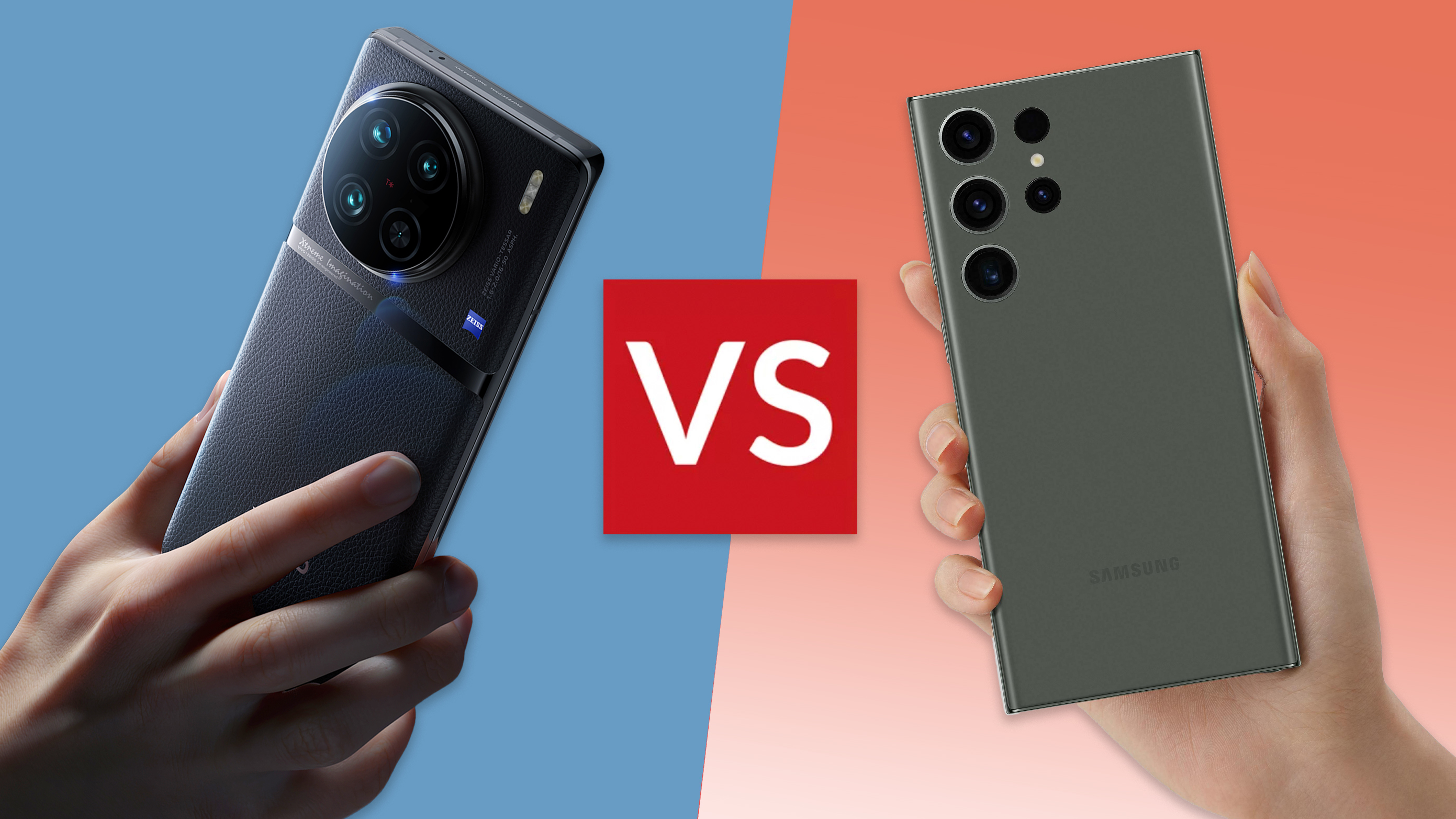
We're about to hit the thick of phone season and that means some big guns have already been announced, vying for their place as the best Android phone of 2023. And there will only be more releases to come, I'm sure.
Hot off the heels of Samsung's Galaxy Unpacked showcase is the Samsung Galaxy S23 Ultra, complete with its 200-megapixel camera. But less than two days after that event, Vivo has revealed the Vivo X90 Pro complete with a totally different and exciting camera take.
Now, Vivo devices might be a scarcer sight in various regions, but you'll have probably seen the company's logo during the World Cup as it's a principal sponsor. And I can attest it makes some great products, including the previous Vivo X80 Pro.
Sure, Samsung is the better-known brand of the pair, with a well-established S series that's been winning accolades when it comes to the best phones, but just because it's the better-known choice doesn't instantly mean it's the better choice. So, let's have it, how do the Galaxy S23 Ultra and Vivo X90 Pro differ and which might you prefer to own?
Price
How much you'll have to pay often has a huge bearing on whether a product appeals. Here's the first stalling block, however, as when it comes to the Vivo X90 Pro there's no official price at this point in time. Its predecessor, the X80 Pro, was £1,199 though, so that's worth keeping in mind.
Very close to that asking price is where the Samsung Galaxy S23 Ultra sits anyway. The 2023 flagship starts at £1,249 in the UK, with 256GB storage as part of that package, making it pricier than the outgoing S22 Ultra.
Design
When it comes to visual aesthetic there's a circular theme on the rear of both of these phones. Except the Vivo X90 Pro goes with one large circular camera enclosure, which is very ono trend with Chinese phones of late, whereas the Samsung opts for five individual circular segments, no singular enclosure housing them all together, with three of those protruding from the rear.
Get all the latest news, reviews, deals and buying guides on gorgeous tech, home and active products from the T3 experts
Personally I prefer how the Samsung looks. I think it stands out more. It also doesn't have the downright peculiar 'Xtreme Imagination' in some pseudo-handwritten font on the rear, which Vivo has inexplicably opted for on the X90 Pro.
I'm not writing-off the Vivo's overall design, though, I suspect the textured rear will feel great, or there's a faux leather one instead, and the Zeiss badging looks classy. I just think the pared-back look of the Galaxy S23 Ultra is more distinct and much prefer that it doesn't descend into the weird world of printed slogans.
Display
In terms of display these two handsets are of a similar size: 6.78-inch for the Vivo X90 Pro, 6.8-inch for the Samsung Galaxy S23 Ultra. The Samsung is the resolution champ, though, with its 1440 x 3880 pixel panel (Vivo delivers 1260 x 2800 instead).
There's barely any difference overall then, although the two are slightly different ratios. It's a 20:9 aspect for the Vivo, a 19.3:9 one for the Samsung. That's why the Vivo is about half a millimetre wider, the Samsung about three millimetres taller by comparison.
In theory the Samsung panel can achieve higher peak brightness, but Vivo's measure of 1300 nits peak is no slouch. Both Samsung and Vivo opt for 120Hz adaptive refresh rates, so you'll get smooth visuals too. In short: there's not much between these two, but Samsung has the slight upper hand in more display feature departments.
Hardware
While Samsung has opted for every Galaxy S23 handset to utilise Qualcomm's Sanpdragon 8 Gen 2 platform (irrelevant of your region; there's no Exynos variant), Vivo has gone the other way and supplied the X90 Pro with the top-end competitor: MediaTek's Dimensity 9200.
I find it kind of fascinating that, on paper at least, both these systems come up as roughly equal. In some areas it's actually MediaTek that has the upper hand. Although Qualcomm's 5G modem tech is further ahead, which could mean better connectivity. I've not tested either in person as yet, though, so cannot verify.
It's here that I also must mention Samsung's use of S Pen stylus, which is stowed into the S23 Ultra's body, and can be pretty transformative a way to work if you like the pen. It's software is really adept at making the most out of it too, but personally I don't have a huge amount of use for it. If you do then you'll love it though.
When it comes to battery the Samsung has a 5,000mAh cell, the Vivo a marginally smaller 4870mAh equivalent. However, Samsung's 45W charging is not a patch on Vivo's 120W dual-cell Flash Charge, which is so quick as the two battery cells within are charged simultaneously and at pace – up to 50% in 8 minutes, or full in under 25 minutes.
Cameras
It's in cameras that there's perhaps the biggest headclash as to which wins. So is it Galaxy S23 Ultra or X90 Pro? It'll most likely depend on what you're looking for, I think. In summary: Samsung gives more zoom and more resolution; Vivo gives more physical sensor scale, plus Zeiss collaboration, so arguably will be able to deliver lower-noise, sharper results. That's the theory anyway.
| Samsung Galaxy S23 Ultra | Vivo X90 Pro | |
| Main camera | 200-megapixel, f/1.7 aperture, 1/1.33in size, optical stabilisation (OIS) | 50-megapixel, f/1.8 aperture, 1in size, optical stabilisation (OIS) |
| Wide-angle camera | 108-degrees, 12MP, f/2.0 | 120-degrees, 12MP, f/2.2 |
| Zoom lens #1 | 3x zoom, 10MP, f/2.4, 1/3.52in, OIS | 2x zoom, 50MP, f/1.6, 1/2.4in, OIS |
| Zoom lens #2 | 10x zoom, 10MP, f/4.9,1/3.52in, OIS | N/A |
The table above shows what each offers, the Samsung with more lenses and, critically that 10x periscope zoom. Increasingly such long zoom lenses are being removed from top-end flagship devices, it seems, and the Vivo certainly doesn't entertain such zoom aspirations.
However, while the Samsung delivers a 3x zoom also, the 10-megapixel resolution isn't the best going, especially when it's packing 200MP into its main camera. The Vivo instead goes with a 50-megapixel resolution at 2x zoom, making for a great portrait lens. I'd prefer the latter out of the two, and seeing as I doubt I'll be using a 10x very often, the Vivo combination to me is more appealing.
But it's the main lens where Vivo plays its trump card: although 'only' 50-megapixels compared to the Samsung's 200MP, the X90 Pro uses a 1-inch sensor size, which is as massive as you'll find in a mobile phone. It's physically large, about 65% more than the Samsung's main sensor, which is really useful for larger 'pixel' sites, capturing light more cleanly, and delivering results that have more data to work with and, theoretically, greater quality in the end product.
I'm not trouncing Samsung's 200-megapixel choice, per se, but having so many pixels isn't necessarily an insta-advantage. Especially as it combines 16 into one for 12.5MP results anyway – and on your phone I really don't think you're going to notice much anyway.
Not to be purposely contentious, but I reckon that Vivo has the winning combination here. I'm only really disappointed that this Pro model lacks the gimbal stabilisation seen in some previous X series models, because it's out-of-this-world good, and while it's on the X90 Pro Plus model, that won't be making its way beyond Chinese markets by the sounds of things.
Conclusion
In terms of style, screen and software, the Samsung Galaxy S23 Ultra is nigh-on untouchable – even more so if you want to make use of the S Pen stylus that's stowed into the body for even more creative solutions. Its camera combination is also super for all kinds of scenarios and the most adept when it comes to zoom.
Despite all those clear positives, however, the Vivo X90 Pro has a few major things on its side: namely that main camera lens, which features a massive 1-inch sensor, and much faster charging. No, I wouldn't expect its software to be as complex, there's no stylus control here, and zoom isn't as far-reaching by a long way – but with the power of Zeiss behind the lenses, you might not care about that for the sake of clarity.

Mike is T3's Tech Editor. He's been writing about consumer technology for 15 years and his beat covers phones – of which he's seen hundreds of handsets over the years – laptops, gaming, TV & audio, and more. There's little consumer tech he's not had a hand at trying, and with extensive commissioning and editing experience, he knows the industry inside out. As the former Reviews Editor at Pocket-lint for 10 years where he furthered his knowledge and expertise, whilst writing about literally thousands of products, he's also provided work for publications such as Wired, The Guardian, Metro, and more.
